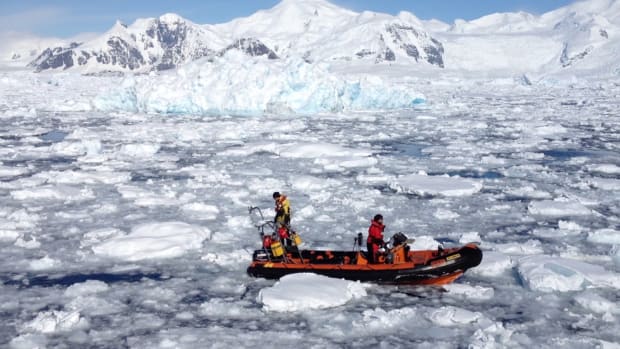
Can microalgae save Antarctica’s melting ice?
Scientists from the UvA are going to research microalgae in the ice sea around Antarctica. These algae could potentially help regulate the climate. “One of the biggest uncertainties is that nobody knows how fast land ice and sea ice will melt and how that affects sea level rise.”
The amount of ice in the Antarctic sea has been historically low in recent years. In addition, there are indications that the melting of the western part of Antarctica is irreversible, according to a new report in which scientists warn of an “unpredictable new phase” in the climate crisis. Yet there is reason to be hopeful too.
Scientists from the University of Amsterdam and the University of Groningen will spend the next five years researching microalgae that may inhibit the melting of the ice caps. “Often scientists look at the carbon storage of tropical rainforests in the fight against the greenhouse effect,” says Susanne Wilken, ecological researcher at the Institute for Biodiversity and Ecosystem Dynamics (IBED) at the UvA and involved in the study. “But perhaps we should focus our attention more on microalgae in oceans. They account for as much as 50 per cent of global carbon fixation and thus contribute significantly to capturing CO2. In addition, some algae have specific properties that enhance cool climates.”

To investigate this, the researchers will travel to the Dutch Dirck Gerritsz Laboratory in Antarctica in the winter of 2026 to sample sea ice. Going earlier was not possible because the British research station Rothera, of which the laboratory is a part, is currently being renovated. “Until then, we are preparing our experiments,” says Wilken. “For example, we have to think about how we are going to measure the contribution of microalgae and how we are going to distinguish different species. We will also conduct lab experiments with microalgae isolated from Antarctic waters to study their physiology under controlled conditions.”
For the study, scientists are interested in the lifestyle of mixotrophic microalgae. Many microalgae are known as photosynthetic organisms, fixating carbon in the oceans. However, there are also microalgae which can feed on other microorganisms in the sea. Specifically, mixotrophic microalgae can both photosynthesize and consume other microorganisms. “Because of this combined lifestyle, mixotrophic algae are able to survive the pitch-dark polar winter and spring,” says Wilken.

To distinguish those mixotrophic algae from other species, mass spectrometrist Gertjan Kramer of the Swammerdam Institute for Life Sciences (SILS) at the UvA, and also involved in the study, has devised a method. Kramer: “The idea is that we grow bacteria here in the lab that carry a label with them - similar to a coloured dot on sheep, but at the molecular level. Once the algae eat these bacteria, we can find the label in their cell. And if that cell then also contains chlorophyll, an essential component for photosynthesis, we know we are dealing with a mixotrophic alga and can start mapping their distribution around Antarctica.”
Antifreeze
Besides their combined lifestyle, mixotrophic algae have another special ability to survive in Antarctica”s ice sea. Using special molecules, they can bind sulphur. Those sulphur compounds act as a kind of antifreeze and salt regulator, Wilken explains. These compounds are essential when sea ice begins to form. Mixotrophic algae then become trapped, so to speak, in the pores of the ice, where the sea salt is also found. “The moment spring arrives in November, the algae want to get rid of these sulphur compounds,” Wilken continues. “They excrete the molecules which eventually turn into a gas that stimulates cloud formation, which in turn blocks sunlight. As a result, microalgae are thought to indirectly play an important role in regulating a cool climate for the preservation of the Antarctic ice sheet.”
How many of these microalgae are present in the Antarctic ice sea remains to be seen. The amount of gases they produce there is also unknown. “We want to understand that interaction between the gases of mixotrophic algae to know more about their contribution to the local climate and ice formation,” says Wilken. Kramer continues: “One of the biggest uncertainties right now is that nobody knows how fast land ice and sea ice will melt and how that affects sea level rise. By adding insights from these algal species to climate models, we might be able to remove some of that uncertainty.”
Kramer adds on an optimistic note: “I think that you might grow algae at scale as a type of biological carbon capture, but this is still in the realm of science fiction and should not divert from efforts to reduce emission.”

